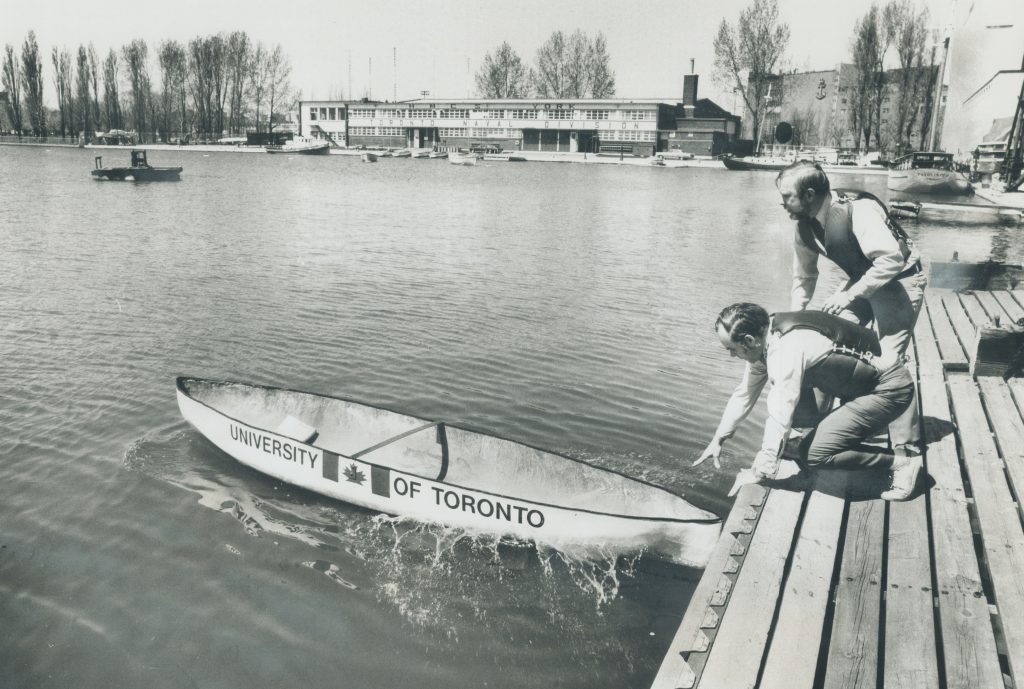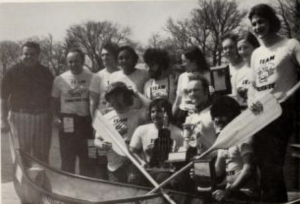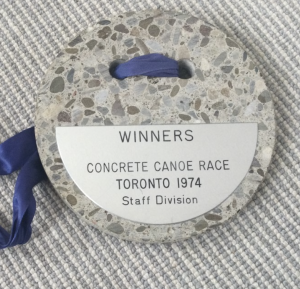June 10, 2021 | NCN – News Channel Nebraska
June 11, 2021 | Water Canada
On June 8, 2021, Toronto City Council approved a plan to update City of Toronto bylaws to allow for the continued use of cargo e-bikes that support businesses in meeting unprecedented demand for local deliveries while also making way for a new micromobility pilot for larger cargo e-bikes.
The proposal received letters of support from UTTRI associated faculty Professor Matthew Roorda, Canada Research Chair, Freight Transportation and Logistics, and Chair of the Smart Freight Centre; The Bike Brigade; The Pembina Institute; and Cycle Toronto.
In his letter of support, Roorda says that greener transportation modes, such as cargo e-bikes for last-mile delivery, are proactive steps for the environment and will open up research opportunities:
“It is no longer news that we are already behind in the race to battle climate change. As such, we must act aggressively and proactively to protect the environment. One such way is to adopt and promote alternative transportation modes, including Cargo E-bikes for last mile delivery.
“This [approval] will enable our current [City Logistics for the Urban Economy] research to proceed with pilot research programs with Cargo E-Bikes on the U of T Campus. This work will positively impact consumer access and drive new business opportunities. At the same time, it has the potential of significantly reducing CO2 emissions.
“There is immense opportunity in this area, we voice our full support for the ongoing policy developments in our city to enable a pilot program Cargo E-bikes of >120kg and up to 1000w in the near future.” – Professor Matthew Roorda, Canada Research Chair, Freight Transportation and Logistics
Professor Roorda and Dr. Ahmed Lasisi from University of Toronto, and Professor Kevin Gingerich from York University, are developing cargo tricycle initiatives on the U of T and York University campuses as part of the City Logistics in the Urban Economy (CLUE) project.
In March 2021, the Province of Ontario introduced a new cargo e-bike regulation and pilot for Ontario municipalities. The provincial pilot requires that municipalities choose to opt-in and change their bylaws to allow for use of any cargo e-bike weighing over 55 kilograms on public streets including bike lanes and cycle tracks.
As part of the provincial pilot, the City has an opportunity to potentially allow for larger cargo e-bikes weighing more than 120 kilograms to be piloted. A pilot project with larger cargo e-bikes would allow the City to evaluate use and impacts of such e-bikes in Toronto. The provincial O. Reg 141/21 Pilot Project – Cargo Power-Assisted Bicycles is available online.
“More people than ever are shopping locally online and relying on quick and efficient delivery services to get their purchases in a timely fashion. Cargo e-bikes represent a great opportunity for local businesses to meet that demand in a way that is environmentally responsible and helps reduce traffic congestion.” – Mayor John Tory
“Continuing to allow cargo e-bikes on Toronto’s streets and cycling infrastructure can help reduce transportation-related greenhouse gas emissions and air pollutants, reduce traffic congestion, and enhance how goods are moved throughout the city.” – Councillor Jennifer McKelvie (Scarborough-Rouge Park), Chair of the Infrastructure and Environment Committee
- Read the City of Toronto Council Agenda Item IE22.15, Regulatory Clarity for Cargo E-bikes – City Council Decision, June 8, 2021.
- Read letter of support for cargo e-bikes in the City of Toronto from Professor Matthew Roorda.
- Read the full City of Toronto June 8, 2021 news release “Toronto City Council approves plan to allow cargo e-bikes to continue to support local businesses and make way for a new micromobility pilot.”
This article originally published by Urban Transportation Research Institute (UTTRI)
Related content
- Toronto Freight and Goods Movement Strategy approved by council
- Smart Freight Centre launches new research collaborations on safer, cleaner and more efficient transport of goods in the GTHA
How a breakfast cereal led to beating U.S. competitors and a patent
For the last 24 years engineering students in Canada have been competing in the annual Canadian National Concrete Canoe Competition (CNCCC) but concrete canoes were being built at U of T long before the first CNCCC event.
In 1973 Civil Engineering (CivE) Professor Emeritus John Timusk and Professor Emeritus Ken Selby launched University of Toronto’s first concrete canoe into the Toronto Harbour. The canoe, which weighed 120 pounds, was completed the night before and took CivE students six hours to make.

At the time Prof. Timusk was working on various mixes for insulated concrete; the first insulating material he used were Styrofoam beads. Then he thought to use an organic material.
“It occurred to me, why don’t we use puffed wheat? Imagine that!” Timusk recalls.
To prevent the cereal grain from going soggy, Timusk experimented dipping the puffed wheat into boiling wax. By a lucky mistake, one of them turned into carbon, from too much heat.
“I said ‘Eureka! we got a product here!,’” Timusk recalls. This led to other formulas for insulated concrete using glass fibres and cement paste, which were later patented by Timusk.
Under the direction of Prof. Timusk, CivE students were using insulated concrete for various extracurricular projects. First, they made a concrete igloo, a concrete motorboat and then came U of T’s first concrete canoe in 1973.
Concrete Canoe races had been held in the United States since the 1960s, with U of T becoming the first Canadian university to enter the competition in 1974, then hosted at Notre Dame University in Indiana.


Using Prof. Timusk’s patented insulated concrete formula, U of T entered with an ultra-lightweight canoe, weighing only 78 pounds.
“Our canoe was so much lighter, we travelled with it on the roof rack of a car,” said Timusk.
The 78-pound winning concrete canoe now resides at the Canadian Canoe Museum in Peterborough, Ont.
Prof. Ken Selby and Prof. Cameron Kenney, who was Department Chair at the time, paddled the canoe in the staff division of the race, winning first place.
The win from the upstart Canadian entry caused jealousy amongst the U.S. universities, who expressly did not want to compete with U of T’s new innovations in concrete. Timusk jokes, "That was probably the first and last concrete canoe competition we went to in the States."
By this time, there were other university concrete canoe races starting in Ontario. Races were held at Grenadier Pond in Toronto’s High Park and at the former Lady Eaton Estate, now a Seneca College campus, near King City, Ont.
Prof. Ken Selby recalls a race at Lake Seneca, where he and Prof. Cameron Kenney were paddling in a staff division race. Three-quarters through the race, Kenney fell out of the canoe into the lake but Selby kept paddling on.
“There were a whole bunch of other boats, so I didn’t want to cause a scene picking him up!” Selby chuckles as he recounts the memory.

For years, Prof. Selby and Prof. Timusk enjoyed concrete canoe competitions. “The more we do this, the more the students become independent, they start to work in teams and this is all in their spare time,” said Timusk.
Today, the U of T Concrete Canoe Club is an interdisciplinary design team, attracting students from all departments in the faculty.
This year the CNCCC went virtual and asked teams to submit an analysis on a past canoe in a technical report. Last month, the U of T Concrete Canoe Team submitted a report on its 2018-2019 canoe, the Polaris, earning second place in the competition.
By: Rebecca Logan
A message for Engineering students, faculty & staff from Engineering Dean Chris Yip
To our U of T Engineering community
More than half of the population in Canada has now received a first dose of a COVID-19 vaccine, and in Toronto, the proportion is over 70% of adults. Second doses are coming, and the Ontario government recently announced its three-phase reopening plan. As I shared in a past Dean’s message, here at U of T Engineering, we’ve also been mapping out our plans for a safe and gradual return to campus.
Our plans are being built from the latest public health guidance and government directives. Indeed, the entire University has been working diligently since the pandemic began to rethink every facet of our operations — from signage and scheduling, to ventilation and vaccination — to ensure the safety of our whole community.
Of course, there are still a lot of questions and details outstanding, but I wanted to provide the outline of our scenario planning, the rationale behind it and the considerations we have made. I know it’s a lot of information, but I am sharing this so that each of you, whether you’re an incoming first-year, returning undergrad, graduate student, staff or faculty member, can begin to imagine how the Fall Term may look for you, and have as much info as possible to make your own plans.
Our leadership team, Departments, Divisions and Institutes, the Registrar’s Office, our Faculty’s Health and Safety advisors, and the Graduate Offices are working hard to develop a schedule that will prioritize as many in-person course activities as possible, while considering student workload, travel or commute times, health and safety and well-being. We also continue to work closely with EngSoc into and throughout the summer on scenario planning for extra-curricular activities such as student teams and orientation.
Review the scenarios planned for the Fall Term:
It is crucial to remember that even if we start the term under one plan, changes in public health guidelines could mean an unpredictable switch. We need to be prepared to pivot and adapt. We advise preparing for both Plans A and B, as these are based on the current provincial health and safety guidelines, which could change. Course instructors are also working to develop in-class delivery under both plans.
My central message is this: plan to be in Toronto. I encourage those who are able to be vaccinated to get their shots, as I have. While I acknowledge the past 15 months have been a grind, and I know many of you have faced challenges in your personal, professional, academic lives and beyond, I’m also enormously energized by the prospect of seeing you on campus again this Fall Term.
There will be bumps in the road ahead, but we’re moving forward. I will continue to keep you updated as we go.
Chris
Christopher Yip
Dean
Faculty of Applied Science & Engineering
University of Toronto
—
Scenario Plans for Fall Term in U of T Engineering
Undergraduate students
Plan A: In-Person Course Activities
- This is our “as in-person as possible” scenario, which involves in-person delivery of all course activities.
- This is our default plan.
- This plan is feasible as long as we do not have any physical distancing or significant gathering limit restrictions imposed by public health guidelines; however, we anticipate the continued use of non-medical masks indoors and outdoors while on campus.
- We hope that in this scenario, small club and student group gatherings will be possible but realize that, at this time, this cannot be guaranteed.
- When registration for U of T Engineering undergraduates opens on July 14, 2021, students will register for courses as if they will take place in person under Plan A.
Plan B: In-Person Pods, Labs & Tutorials
- The University has asked all divisions to develop a Plan B in the event that public health guidelines do not allow us to proceed with Plan A.
- U of T Engineering’s Plan B is based on a hypothesis of having the strictest public health restrictions that would still enable us to facilitate some in-person activities: gathering limits of 50, and no physical distancing requirements. We also anticipate the continued use of non-medical masks indoors and outdoors while on campus.
- Since not all course components can be in-person under Plan B, we are prioritizing those smaller in-person activities that are focused on hands-on and/or interactive experiences, which are generally the laboratories and tutorials.
- With gathering limits of 50, the numbers of tutorial and laboratory sections drastically increase. In this scenario, with the anticipation of classrooms being fully utilized (at low capacities), U of T Engineering does not have the space required to satisfy public health restrictions that would allow students to congregate, wait, study or attend synchronous online lectures between their in-person labs and tutorials.
- We also do not have the space required for students to wait and study within our buildings between course activities. We are being mindful to avoid crowded and congested spaces.
- Therefore, Plan B involves designing cohorts of undergraduate students in Years 1 and 2, divided into ‘pods’, whereby each pod’s in-person course activities (labs and tutorials) are scheduled together, so that they can leave campus when they are done their in-person activities for the day. Due to the custom nature of Years 3 and 4, we do not have a pod structure for upper-year students.
- In developing a Plan B, we are prioritizing in-person labs and tutorials over synchronous online lectures. While we understand that this is not ideal for every course, we believe this will provide students with a better overall experience, addressing their desire for in-person peer-to-peer interaction.
- Since undergraduates will be grouped into pods, we are encouraging students to come to campus only on days when they have in-person course activities.
- In this scenario, we expect that all extra-curricular activities will stay virtual. If a club or design team has a specific request or concern, they are encouraged to first coordinate with EngSoc, whom we have been working with continuously through the pandemic and into this summer.
Plan C: Remote (with some exceptions)
- If physical distancing is required, then the vast majority of in-person activities will not be feasible. We will run our Plan A schedule for undergraduate courses, but it will be fully remote with the exception that some programs will still hold some in-person laboratories.
- All extra- and co-curricular activities will also be remote under Plan C.
Graduate students
Plan A: In-Person Under 50
- If public health guidelines require little or no or physical distancing or gathering limits, for graduate courses where the class size is smaller than 50, the default plan is to be in-person as much as possible.
- We anticipate the continued use of non-medical masks indoors and outdoors while on campus.
- For courses where the class size is 50 or more, the default plan is online lectures with in-person components in small groups. For example, when possible, these could include in-person office hours scheduled in a classroom, while still offering a portion of the office hours online.
- Course enrolment opens for graduate students on August 4, 2021. Students will register in courses as if we are proceeding with Plan A.
Plan B: Remote (with some exceptions)
- If significant physical distancing and gathering limits are still in place: most classes will be delivered remotely.
- In-person course activities that are possible under public health requirements, and that can be delivered equitably for all members of the class may be held in person.
—
Quick links:
- Undergraduate student FAQs
- Graduate student FAQs
- UTogether: Your guide to summer and fall 2021 at U of T
- International student arrival
- Quarantine information for students entering Canada
- Residences and Off-campus housing
- 24/7 counselling support through My Student Support Program (My SSP)
This message originally posted by U of T Engineering
June 1, 2021 | Hindustan Times

U of T researchers are among those in a large multidisciplinary and multi-institutional project to track Ontario’s microplastics pollution.
CivMin Professor Elodie Passeport (jointly appointed with ChemE), along with Profs. Miriam Diamond (Earth Sciences and ChemE.), Maria Dittrich (UTSC) are all co-principal investigators (PI) on a project awarded a grant from the Natural Sciences and Engineering Research Council of Canada (NSERC). The PI is Prof. Jill Crossman at University of Windsor (UWindsor), who is coordinating the project.
In an announcement Monday, May 31, Minister of Environment and Climate Change, the Honourable Jonathan Wilkinson, and Minister of Innovation, Science and Industry, the Honourable François-Philippe Champagne, announced the Government of Canada is providing close to $7 million to support seven science-based research projects. Passeport and colleagues from partner universities are to receive a nearly $1 million grant from NSERC and Environment and Climate Change Canada’s (ECCC) Plastics Science for A Cleaner Future program for their project, “Source-specific identification, characterization and control of microplastics across a remote, rural and urban gradient.”
The multidisciplinary, multi-institutional project is to develop new tools to test, analyze and track Ontario’s microplastics pollution. Researchers must solve the mystery of where microplastics originate, as well as how they travel and where they end up, before the major international pollution problem can be curtailed.
“There are severe knowledge gaps limiting our ability to track plastics already in the environment and these gaps remain a key roadblock to efficient policy implementation,” says Dr. Crossman.
“Canadian and international concern is mounting regarding risks associated with microplastic ubiquity, accumulation and potential for ingestion– particularly now that they are being found in such remote environments, so far from any obvious sources. To get a clear picture of where microplastics end up, we will be tracking and testing what proportion of microplastics are found in the atmosphere, in watersheds and in soil in remote, rural and urban areas across Ontario,” says Crossman.
The UWindsor team, headed by Crossman, is joined by researchers from the University of Toronto, Trent University, and Western University; an industrial partner Wilson Analytical; and scientists from Environment Canada, Ontario Ministry of Environment Conservation and Parks, and the Toronto Region Conservation Authority. The researchers will visit various industrial, agricultural and urban sites throughout the year to identify key sources, transportation processes and pathways of microplastics. The program will become an important resource for future research through the creation of an open access data portal. Crossman’s focus will be on developing and calibrating watershed models, supported by the databases developed within the program, which will be used to identify source contributions and sustainable control measures.
Before collecting any data however, the group will develop uniform investigation methods for analyzing samples of air, water and soil and create a harmonized microplastics surveillance network.
“The research is designed around a cross-institutional training and graduate exchange program, enabling students to gain experience on a wide range of analytical instruments as they travel between universities,” says Crossman.
In addition to developing standards for existing methods, new analytical tools and approaches will be investigated. Dr. Mundle, a professor at the School of Environment and researcher with the Great Lakes Institute for Environmental Research (GLIER) will develop new isotope finger-printing methods that will be used for source tracking of microplastics across Ontario. Dr Mundle says “we will use recent developments in mass spectrometry methods to isolate previously unidentifiable environmental processes, generating unique fingerprints of δ2H, δ15N and δ13C which vary by polymer, region of manufacture and environmental degradation process. This will enable users to track microplastics in the environment back to their original source”
By working directly with municipal and federal stakeholders, and engaging with a diverse group of collaborators, the program aims to develop knowledge which will be directly applied to support effective microplastics mitigation policies which can be used across Canada.
Funding allocation listed here.

Three U of T Engineering projects have been selected for funding by the eCampusOntario Virtual Learning Strategy – a historic $50 million investment by the Ontario Ministry of Colleges and Universities. One of the projects selected involves CivMin Professor Oya Mercan, who heads the Centre for Climate Science and Engineering (CSE).
Engineering in a Changing Climate brings together University of Toronto Scarborough Department of Physical and Environmental Sciences Professor Karen Smith, and U of T Engineering Professor Mercan to develop a transdisciplinary learning opportunity that will allow engineering and climate science students to study climate-related stress on infrastructure.
For a full list of funded projects, visit: uofteng.ca/VLS
May 27, 2021 | Mother Jones
May 26, 2021 | Global News